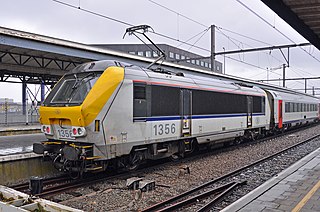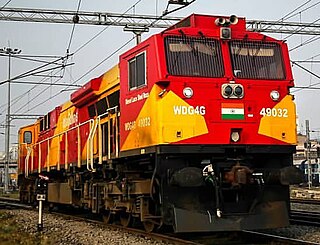
Ruston & Hornsby was an industrial equipment manufacturer in Lincoln, England founded in 1918. The company is best known as a manufacturer of narrow and standard gauge diesel locomotives and also of steam shovels. Other products included cars, steam locomotives and a range of internal combustion engines, and later gas turbines. It is now a subsidiary of Siemens.

Prima is a family of railway diesel and electric locomotives built by Alstom. Manufacture of the type commenced in the late 1990s. By 2008, Alstom had reportedly sold 1,750 Prima locomotives. The second generation Prima II was launched in 2009. The Prima H3 diesel/battery hybrid locomotive was launched in 2013.

Wagon Pars is an Iranian train and locomotive manufacturer established in 1974, in Arak. Products include locomotives, trains, metros, freight and fuel railroad cars, and equipment for passenger boarding of aircraft. It is the largest rolling stock manufacturer in the Middle East.

The ALCO RSD-1 was a diesel-electric locomotive built by the American Locomotive Company (ALCO). This model was a road switcher type rated at 1,000 horsepower (750 kW) and rode on three-axle trucks, having a C-C wheel arrangement. It was often used in much the same manner as its four-axle counterpart, the ALCO RS-1, though the six-motor design allowed better tractive effort at lower speeds, as well as a lower weight-per-axle. It was developed to meet the need to supply the Soviet Union over the Trans-Iranian Railway starting in mid 1943. On the other hand, due to the traction generator and appurtenant control apparatus being sized for four axles and yet having two additional powered axles, it had poorer performance at higher speeds.

Alstom Traxx is a modular product platform of mainline diesel-electric and electric locomotives. It was produced originally by Bombardier Transportation and later Alstom, and was built in both freight and passenger variants. The first version was a dual-voltage AC locomotive built for German railways from the year 2000. Later types included DC versions, as well as quadruple-voltage machines, able to operate on most European electrification schemes: 1.5/3.0 kV DC and 15/25 kV AC. The family was expanded in 2006 to include diesel-powered versions. Elements common to all variants include steel bodyshells, two bogies with two powered axles each, three-phase asynchronous induction motors, cooling exhausts on the roof edges, and wheel disc brakes.

The Islamic Republic of Iran Railways is the national state-owned railway system of Iran. The Raja Passenger Train Company is an associate of the IR, and manages its passenger trains. The Railway Transportation Company is an associate of the IR, which manages its freight transport. The Ministry of Roads & Urban Development is the state agency that oversees the IRIR. Some 33 million tonnes of goods and 29 million passengers are transported annually by the rail transportation network, accounting for 9 percent and 11 percent of all transportation in Iran, respectively (2011).

The Class 13 are a type of mixed use 200 km/h (124 mph) multivoltage electric locomotive of type Traxis designed by Alstom in the late 1990s for the Belgian and Luxembourgish railways.

The Prima Diesel-electric locomotives are a class of medium and heavy, four- and six-axle, passenger and freight mainline locomotives. They have been built both to 1,435 mm standard and 1,668 mm broad gauges, and find use in the Middle East, Europe and North America. Alstom is the primary designer in cooperation with both General Motors and Siemens.

The Eurorunner family of locomotives are a series of medium- to high-power diesel-electric locomotives built by Siemens for the European market. Introduced from 2002 onwards, they share design characteristics with the successful Eurosprinter range of electric locomotives, also built by Siemens.

Railway electrification in Iran describes the past and present electrification systems used to supply traction current to rail transport in Iran with a chronological record of development, a list of lines using each system, and a history and a technical description of each system.
MATRAI is the sum of abbreviations of RAI and MAT and means Iran Railway Research Center.

The Iranian railway equipment industry started its activity with wagon production.
Iran Heavy Diesel Manufacturing Company(DESA), is an Iranian company which is a manufacturer of heavy diesel engines from 200 to 3500 kW for railway, marine and power generation purposes.
The RK 215 is a line of diesel engines built by MAN. The RK 215 series is a large four-stroke diesel engine that has an 11-liter displacement per cylinder.

The HXD2 is a electric locomotive are a series of related locomotive classes built by CNR Datong Electric Locomotive and Alstom. The locomotives designs are based on the Alstom Prima electric locomotives, and are a product of a cooperation agreement signed between the two companies in 2004. All locomotives are intended for heavy freight work, including coal trains on the Datong Qinhuangdao line.

The JT 42BW is a class of four axle Bo'Bo' diesel electric locomotives manufactured by Alstom's Meinfesa plant in Spain for Israel Railways (IR). The locomotives were the primary passenger locomotive unit used by IR through the 2000s.

The JT 42CW is a class of six axle Co'Co' diesel electric freight locomotives manufactured by Alstom's Meinfesa plant in Valencia Spain in the late 1990s for use by Israel Railways (IR).

The Indian locomotive class WAG-12B is a class of 25 kV AC electric locomotives that was developed in 2017 by Alstom with technological collaboration with Indian Railways. The model name stands for wide gauge(W), Alternating Current (A), Goods traffic (G) locomotive-12 . They entered trial service in 2019. A total of 370 WAG-12B have been built at Electric Locomotive Factory, Madhepura, Bihar, India.
The Diesel Locomotive Factory, Marhowrah is a joint venture of GE Transportation of the US with Indian Railways for the production of 1000 high-power freight locomotives over a period of 10 years designed to run on Indian railway tracks. This factory is located at Marhaura and started manufacturing the locomotives from September 2018.

The Indian locomotive class WDG-4G is a class of dual-cabin freight-hauling diesel-electric locomotive used by the Indian Railways (IR). The locomotive is designed by GE Transportation and is based on its Evolution Series, which are used in North America. The class is meant for freight hauling and replaces the older American Locomotive Company (ALCO)-designed locomotives, which have been the mainstay diesels of Indian Railways since 1962. Equipped with a 12-cylinder fully turbocharged GEVO engine, it is claimed to be 50% more environmentally friendly than its predecessors and is the first in the country to be compliant with level one of the emission norms set by the International Union of Railways (UIC-1). The locomotive has two cabs for easy reversal, both of which are air conditioned.
















